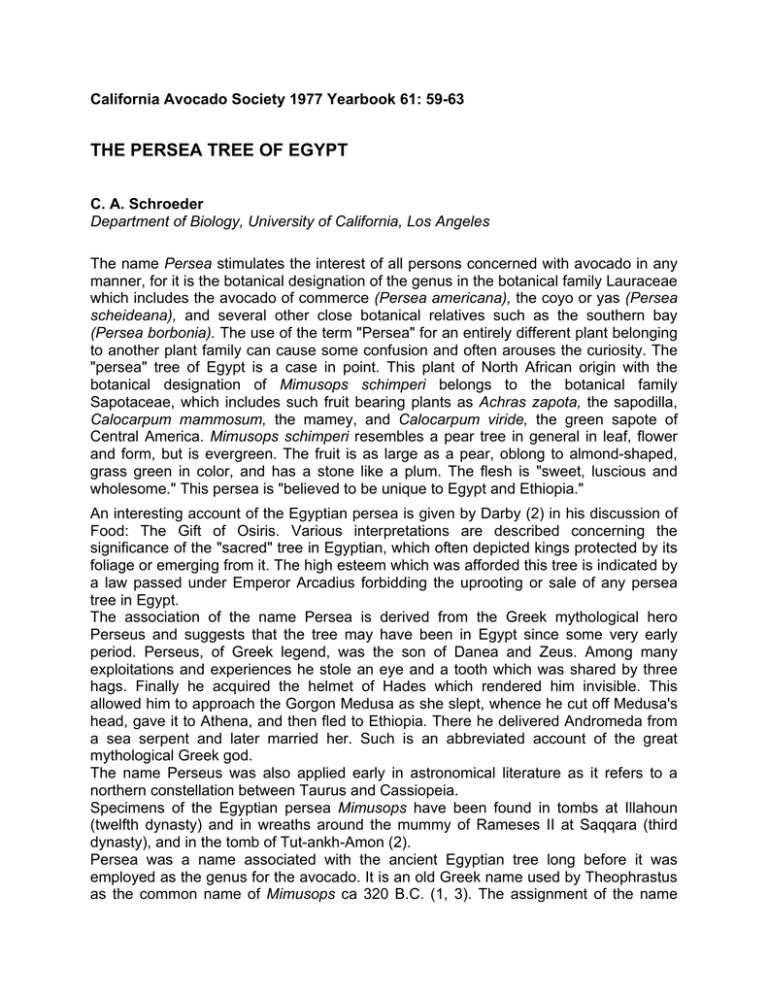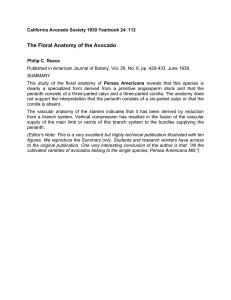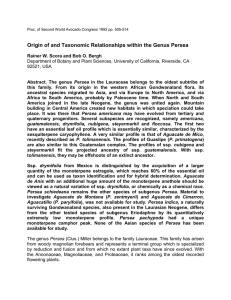THE PERSEA TREE OF EGYPT
advertisement

California Avocado Society 1977 Yearbook 61: 59-63 THE PERSEA TREE OF EGYPT C. A. Schroeder Department of Biology, University of California, Los Angeles The name Persea stimulates the interest of all persons concerned with avocado in any manner, for it is the botanical designation of the genus in the botanical family Lauraceae which includes the avocado of commerce (Persea americana), the coyo or yas (Persea scheideana), and several other close botanical relatives such as the southern bay (Persea borbonia). The use of the term "Persea" for an entirely different plant belonging to another plant family can cause some confusion and often arouses the curiosity. The "persea" tree of Egypt is a case in point. This plant of North African origin with the botanical designation of Mimusops schimperi belongs to the botanical family Sapotaceae, which includes such fruit bearing plants as Achras zapota, the sapodilla, Calocarpum mammosum, the mamey, and Calocarpum viride, the green sapote of Central America. Mimusops schimperi resembles a pear tree in general in leaf, flower and form, but is evergreen. The fruit is as large as a pear, oblong to almond-shaped, grass green in color, and has a stone like a plum. The flesh is "sweet, luscious and wholesome." This persea is "believed to be unique to Egypt and Ethiopia." An interesting account of the Egyptian persea is given by Darby (2) in his discussion of Food: The Gift of Osiris. Various interpretations are described concerning the significance of the "sacred" tree in Egyptian, which often depicted kings protected by its foliage or emerging from it. The high esteem which was afforded this tree is indicated by a law passed under Emperor Arcadius forbidding the uprooting or sale of any persea tree in Egypt. The association of the name Persea is derived from the Greek mythological hero Perseus and suggests that the tree may have been in Egypt since some very early period. Perseus, of Greek legend, was the son of Danea and Zeus. Among many exploitations and experiences he stole an eye and a tooth which was shared by three hags. Finally he acquired the helmet of Hades which rendered him invisible. This allowed him to approach the Gorgon Medusa as she slept, whence he cut off Medusa's head, gave it to Athena, and then fled to Ethiopia. There he delivered Andromeda from a sea serpent and later married her. Such is an abbreviated account of the great mythological Greek god. The name Perseus was also applied early in astronomical literature as it refers to a northern constellation between Taurus and Cassiopeia. Specimens of the Egyptian persea Mimusops have been found in tombs at Illahoun (twelfth dynasty) and in wreaths around the mummy of Rameses II at Saqqara (third dynasty), and in the tomb of Tut-ankh-Amon (2). Persea was a name associated with the ancient Egyptian tree long before it was employed as the genus for the avocado. It is an old Greek name used by Theophrastus as the common name of Mimusops ca 320 B.C. (1, 3). The assignment of the name Persea as the genus for the avocado of the New World was made by Miller in 1754 (4), Two other genera have been associated with the term persea. Lehner (5) refers to Balanites aegyptica (the bito tree) and Smith (6) mentions Cordia myxa (Borraginaceae) as the Egyptian persea. The latter is from Asia and Australia, hence is probably an incorrect identification. Balanites belongs to the family Balanitaceae (Zygophyllaceae), hence is not related to the avocado LITERATURE CITED 1. CHITTENDEN, F. J. (ed.) 1951. The Royal Hort. Soc. Dictionary of Gardening. Vol. Ill: JE-PT. Oxford, Clarendon Press 2. DARBY, W. J., P. GHALIONGUI and L GRIVETTI. 1977. Food: The Gift of Osiris, Vol. II. Academic Press, New York 3. PLOWDEN, C. C. 1968. A Manual of Plant Names. Alien and Unwin, London. 4. KOPP, L. E, 1966. A Taxonomic Revision of the Genus Persea in the Western Hemisphere (Persea Lauraceae). Mem. New York Bot Gard. Vol. 14, No. 1. 5. LEHNER, ERNEST and JOHANNA. 1960. Folklore and Symbolism of Flowers, Plants and Trees. Tudor Publ. Co., N.Y. 6. SMITH, A. W. 1972. A Gardener's Dictionary of Plant Names Cassell, London.



